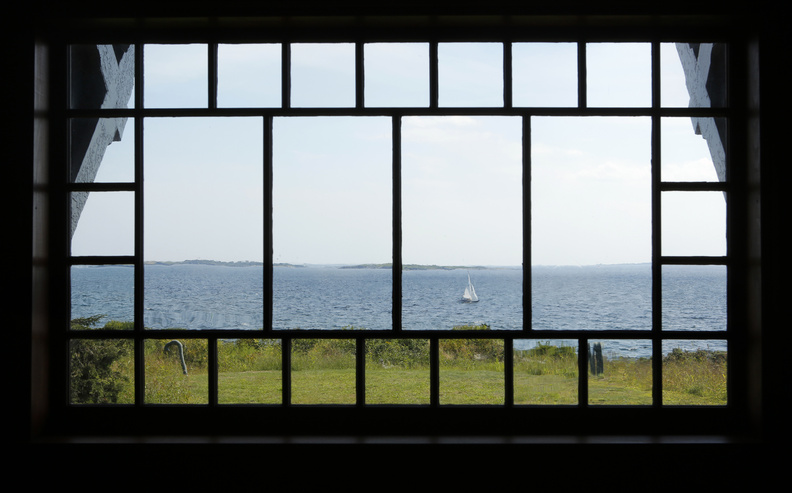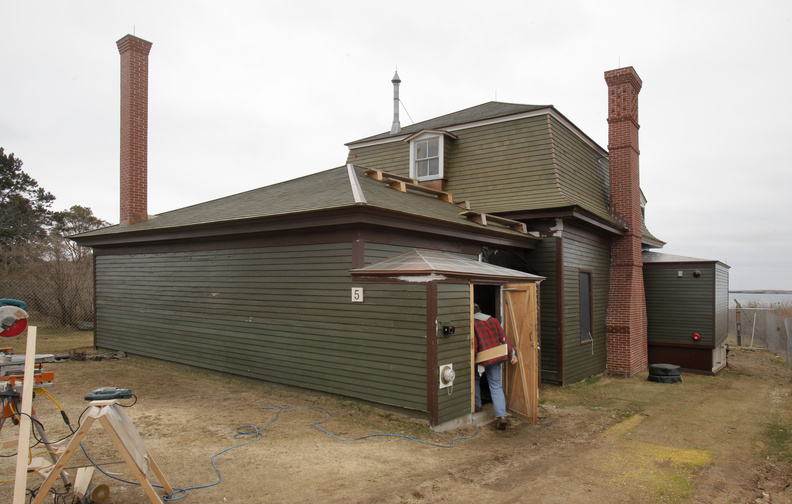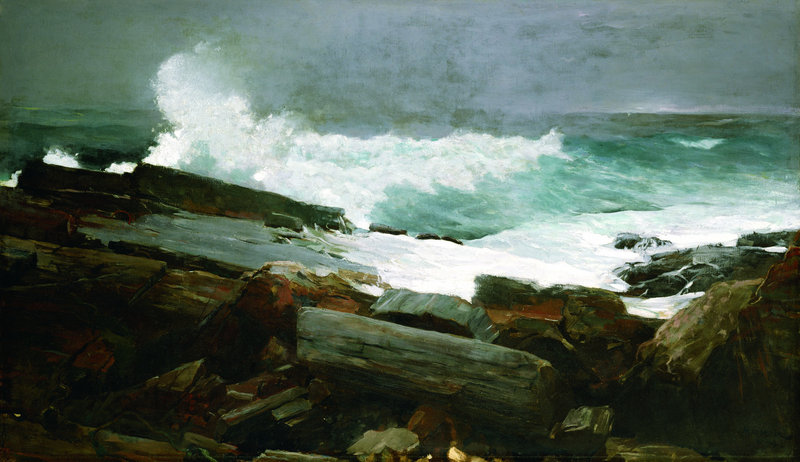SCARBOROUGH – Winslow Homer came to Maine and looked outward into the infinite. What he saw when he arrived at land’s end changed not only his personal perspective of the world and his mortal place in it, but also the course of American art.
From a simple, austere painting studio at Prouts Neck just south of Portland, the Boston-born painter cast his vision to the sea and established a reputation as the most important American painter of his generation and for generations to come.
The significance of the Prouts Neck studio and the art that Homer (1836-1910) made there during the final 27 years of his life will get a lot of attention this fall, in Maine and across the art world.
On Sept. 25, the Portland Museum of Art opens the wood-walled studio to the public for the first time since an extensive restoration project returned it to how it looked when Homer lived and created there. On Saturday, the museum unveils a major exhibition that focuses on the paintings he made there.
At Prouts Neck, Homer created powerful seascapes and contemplated the force and role of nature in a society grappling with technological change. The paintings he made there reached for something more than mere narrative descriptions that defined his earlier work, and suggested existential themes that resonated with and influenced his modernist descendants of the early 20th century.
He began to reconcile his own mortality, and infused modernist themes in his representational works. In doing so, he made it possible for the next generation of artists to take those ideas to new levels.
American art changed with Homer. And Homer changed it while in Maine.
“Homer is our most important American artist, or one of them. He is certainly our great painter of nature,” says retired Princeton University art professor and part-time Maine resident John Wilmerding. “To have the place where he made his art available to us is one of the most significant developments in American art in quite some time.
“It’s important, because it allows us to understand how the art was made and where it came from.”
THE ART WORLD’S BEEN WATCHING
The Prouts Neck studio project is the culmination of a six-year, $10.8 million fundraising campaign that paid for the studio’s purchase and preservation, an endowment, land acquisition, a major exhibition and scholarship, and related expenses.
Its restoration has reverberated nationally. The museum has already received extensive media coverage from The New York Times, Architectural Digest, Martha Stewart Living, Art + Auction, Preservation magazine, National Geographic Traveler and many others. “CBS Sunday Morning” filmed a segment that will air in the fall.
The museum purchased the studio from Homer’s heirs in 2006 for $1.8 million. It sits a stone’s throw from the water’s edge, 12 miles from downtown Portland.
To the best knowledge of the architects and scholars who worked on the project, the small, simple building is almost exactly as it was when Homer lived there from 1883 until his death in 1910 at age 74.
With its bare walls still adorned with the artist’s hand-scribed notes, the studio resonates with the patina of Homer’s presence. Visitors will see where he set up his easel, his furniture, his smoking pipe, water can, family photographs and other artifacts from his daily life.
Most notably, the studio offers visitors the same views of the sea and the rugged coast that Homer enjoyed when he made his iconic seascapes and other late-career paintings. Here, nestled in the wealthy summer enclave that Homer’s family helped establish, we see how he translated the environment into canvas, and can share his sensuous experience — the sights, sounds and smells of the ocean.
We can imagine his life here.
“It’s terrific to have the very magical place where we can see today very much the same landscape that he was seeing, and then have a better grasp of the site-specificity of his works. They were not imagined,” said Wanda M. Corn, a retired art professor from Stanford University.
Particularly from a second-story piazza that stretches across the seaside face of the green cottage, visitors get a sense of Homer’s private world.
It was from this southern balcony that Homer hung his canvases to dry. He walked out onto the lawn, his back to the sea, and gazed up at his dangling paintings to decide if they were finished or in need of more attention.
“I’ve stood on that piazza probably 100 times in six years,” said Thomas Denenberg, former chief curator of the Portland Museum of Art and now the director of the Shelburne Museum in Vermont. “I’ve certainly come to recognize the waves and the rocks, but what I have really come to understand is the creative genius at work.
“I came into this career skeptical of genius. You leave after a half-dozen years working on Homer convinced that you are in the presence of genius with his paintings. That is an odd thing for me to say. But Homer’s paintings provoke awe.”
In advance of the studio’s opening, the PMA will premiere a new exhibition Saturday in its downtown galleries that puts that genius on display.
“Weatherbeaten: Winslow Homer and Maine” focuses exclusively on the paintings, watercolors and etchings that Homer made while in residence at the studio. It includes more than three dozen masterworks, including his 1893 oil painting “Fox Hunt,” which some art historians consider one of the most important paintings in the United States.
REVISITING THE ARTIST’S TIME
Homer’s younger brother, Arthur, first came to Prouts Neck on his honeymoon in 1875. The entire family came along, and spent the summer on the neck.
Homer was already a world-renowned painter when he came to Maine in 1883 at age 47. He came at the suggestion of his older brother, Charles, who was developing the neck as a summer enclave. His aging father also was there.
It was hardly remote, as Homer often portrayed it. The community had several hotels, and Homer had only to raise a flag at his cottage to summon lunch. As Denenberg noted, the artist looked south to the sea for his remote views, because had he turned and looked in the opposite direction, he would have faced the side of a shingled resort hotel.
The Homer family had financial means. His older brother made his money selling a boat varnish known as Valspar. The brand is still around today and is owned by a popular national home-improvement chain. The Prouts Neck development represented a commercial venture for the family, not necessarily a getaway.
But at the time — a generation before L.L. Bean began his sporting goods store — Maine was considered a frontier. It had a reputation as a wild place, and Homer accented that image with his work.
His painting studio originally served as the carriage house to a larger family home, situated immediately to the west. Homer engaged Portland architect John Calvin Stevens to move the carriage house to an adjacent lot and redesign it as a studio and summer cottage.
The museum’s preservation project involved taking the studio back to Homer’s time. Over the years, Homer’s family made many changes to the building, adding a kitchen to the west and dividing the open upstairs loft into several smaller rooms, said lead architect Craig Whitaker of Mills Whitaker Architects.
But the family did not alter the character of the place, and the changes they made were relatively minor and reversible.
“They did a great job over the years preserving the integrity of the place,” Whitaker said. “They always paid homage to Homer. They knew how important he was, and took care to not disturb the essence of the studio.”
Whitaker and his partner, Don Mills, spent many hours in museums and libraries in search of photos and documentation that informed their work. The museum commissioned an architectural dig, and hired a team of mostly Maine specialists and craftsmen to do the bulk of the preservation work.
Among other things, the dig turned up two paintbrush handles, which are on view in the PMA’s Sweat Galleries in Portland. Also on view in Portland are Homer’s easel, paint box and oil-skin hat.
The museum divided up the artist’s personal artifacts between the downtown campus and the Prouts Neck studio so visitors who do not go to the studio can get a sense of the place and how Homer lived there.
‘THIS PLACE CHANGED HIM’
At the studio, no detail was too small when it came to the preservation.
The lattice that craftsmen made for the veranda looks exactly as it did in Homer’s time, based on historical photos. The twin chimneys, which form an iconic image of the studio, were reconstructed and repointed. The fireplace was rebuilt brick by brick. The patina of the wood-stained walls was largely untouched.
If we could turn back the clock, it would be 1890 — with a modern sprinkler system, electronic surveillance and other 21st-century features that are largely hidden from public view.
It is a spartan, simple cottage. Homer lived here mostly in the summer, fall and into early winter. The building was not insulated, although the large fireplace offered some heat.
The artist left his mark. He scratched his name in the glass of a window and scribbled notes on the walls. All those notes have been preserved, including one written in pencil: “Oh what a friend chance can be when it chooses.” The quotation is from the novel “The Clique of Gold,” which sits on Homer’s library shelf.
The bottle jack that Homer used for roasting meat dangles from the ceiling by the fireplace. On the mantel is a sign he set out to discourage visitors: “Snakes — Snakes! Mice!” Bounties of his hunting and fishing expeditions hang on the walls.
Homer’s reputation as a painter became much grander after he came to Maine. His time at the studio affected him in dramatic ways, said museum director Mark Bessire, who inherited the project from his predecessor, Daniel O’Leary.
“His art was always a part of forging our national identity,” Bessire said. “He made a lot of really important paintings before he came to Maine. He was already the voice of his generation. But then he comes to Maine, and the platform changes. He becomes the voice for the next generation too.
“When he turns his focus to nature, he finds his true calling, which is painting the world in front of him. This place changed him. It’s all about the place. That is our mantra.”
Homer also is a pivotal figure in Maine art. Frederic Edwin Church painted in Maine before him, but Homer is viewed as the father of Maine art. Because of his presence here and his success as an international artist, others came to Maine after him in search of some of the themes that Homer captured in his work.
If not for Homer, Maine very likely would not have been a draw for N.C., Andrew and Jamie Wyeth, John Marin and countless others, Bessire said. If not for Homer, Marsden Hartley might not have come home.
WHERE HE COULD ‘FACE THE INFINITE’
The studio project represents the most significant cultural investment the museum has made, Bessire said. The PMA raised more money a decade ago to restore and reopen the McLellan House and Sweat Galleries, but that project was much larger in physical scope. It involved two buildings with many rooms, each of which demanded attention.
The Homer studio is relatively small — just 2,400 square feet — but it represents one of America’s most important cultural landmarks, Bessire said. It was named a National Historical Landmark in 1966.
The preservation of the studio was an obligation, Bessire said.
“We needed to do this, because the studio might have gone into private hands,” he said. “It was not an easy decision to take on something that is not about generating new revenue. It’s about recognizing the importance of American culture. It’s about our heritage.”
Homer is deeply entwined with the history of the Portland Museum of Art. He exhibited there in 1893, when it was known as the Portland Society of Art.
In 1976, philanthropist Charles Shipman Payson pledged his collection of 17 Homer paintings and watercolors, along with an endowment that led to the construction of the museum’s modern Payson wing, which opened in 1983. In addition to the Payson paintings, the museum’s Homer collection includes 400 illustrations.
Significantly, almost half of the money raised for the studio project came from out of state, Bessire said. Typically, the museum’s capital campaigns are funded predominantly with money from Maine. That this one reached so far afield is testament to the national importance of this project, said Bessire.
The museum also secured the single largest corporate sponsorship in its history to help fund the “Weatherbeaten” exhibition, from Bank of America. Bessire declined to say how much the Bank of America sponsorship is worth.
Additionally, the museum went to extraordinary lengths to insure the art that is on view in the “Weatherbeaten” show. The value of the work is so high — Bessire declined to guess how high — that the PMA secured indemnity insurance from the federal government. The paintings come from many of the most prestigious museums in the country.
The museum hopes to capitalize on the studio opening and related exhibition. A new attendance record is not out of the question, Bessire said, and the museum has created a line of Homer merchandise, including a Homer bobblehead doll.
Wilmerding, the retired art historian from Princeton, has visited the studio many times over the years. He’s always appreciated the simplicity of it.
Now that Homer’s place looks and feels as it did when the artist lived there, Wilmerding better understands the role of the studio in Homer’s life, and on the man himself.
“I am impressed by the raw nature and the austerity of it, the restraint,” he said. “There is very little materialism here. The materialism is in the landscape itself. The wonderful sense of the character of the landscape can be seen in this very humble place.
“In that studio, Homer was able to face the infinite as his own life moved into the older years. That landscape gave him the sustenance to face the largest questions of life and the imminence of death itself.”
Staff Writer Bob Keyes can be contacted at 791-6457 or:
bkeyes@pressherald.com
Twitter: pphbkeyes
Send questions/comments to the editors.





